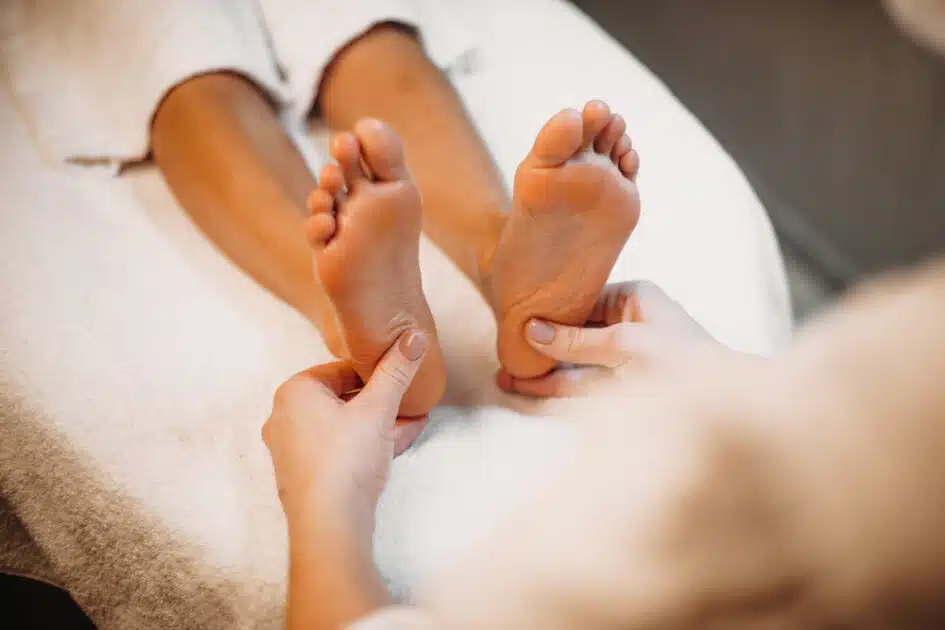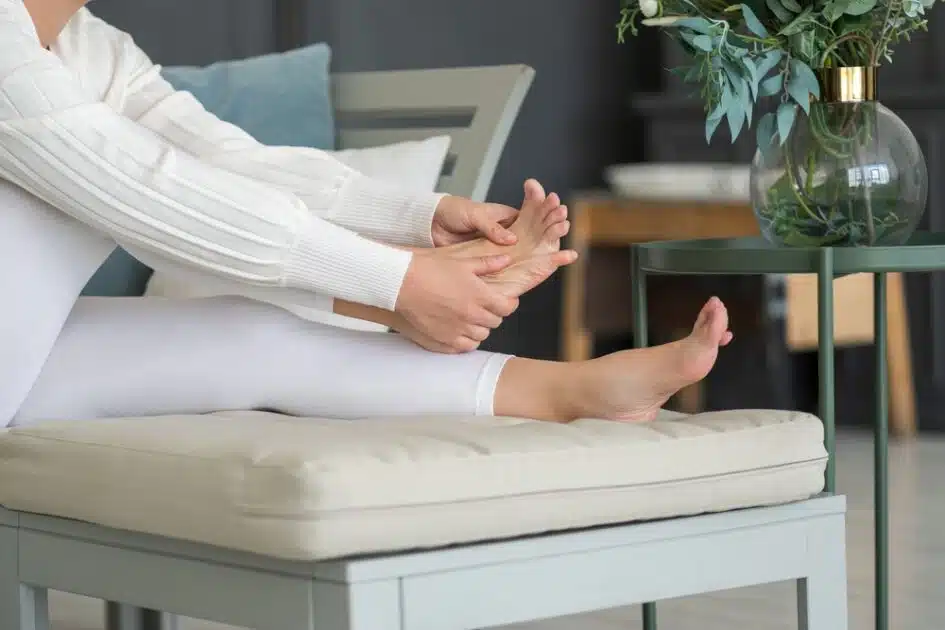Massage for Plantar Fasciitis

Relieve Foot Pain and Promote Healing with Massage Therapy for Plantar Fasciitis
What is Massage 25th Jul, 2023
Plantar Fasciitis, a term you’ve probably heard in passing, may seem elusive until you’ve had the unfortunate experience of encountering it firsthand. As a prevalent source of foot discomfort, it frequently wreaks havoc on an individual’s ability to enjoy simple daily activities, let alone indulge in their favorite athletic pursuits. Plantar Fasciitis tends to behave like an uninvited guest that overstays its welcome, causing distress and discomfort.

Nonetheless, the good news is that you’re not defenseless in the face of this persistent pest. There exists a wealth of home-based remedies, with a significant emphasis on stretches and foot massages, that can potentially keep recurrent bouts of Plantar Fasciitis at bay.
Through this comprehensive guide, our aim is to equip you with an arsenal of easy-to-implement, self-administered massage techniques that may offer respite from the nagging pain caused by this common condition. Read on to discover how to turn the tables on Plantar Fasciitis and reclaim the comfort of your feet.
Right Conditions for a Calming Foot Massage
A foot massage’s preparation is just as significant as the massage itself. Take a minute to think about these precautions before diving into the realm of foot massages:
1. Gentle Touch
Although a foot massage may be quite therapeutic, it’s important to proceed with caution. High-pressure regions should not be touched deeply, especially if they are painful or uncomfortable. Instead, concentrate on using a gentler touch and escalating the pressure as your condition becomes better.
2. Gradually Increasing Pressure
It’s advisable to start with a gentler touch and gradually increase the pressure while giving a foot massage. This strategy avoids needless tension or discomfort by allowing your muscles and fascia to adapt to the massage. Feel free to apply a little bit more pressure as you get more at ease, as long as it stays within a comfortable range.
3. Enhancing Blood Circulation
Warming up your feet before a foot massage is a good idea. This may be accomplished by lightly rubbing them to stimulate blood flow there. Warm feet offer improved relaxation and therapeutic benefits since they are more responsive to massage.
4. Moisturize
Consider using a tiny bit of moisturizer to improve the massage sensation. Applying a little moisturizer not only makes it easier for the hands to move over the skin, but it also hydrates the foot more, making it feel supple and soft. For maximum comfort, pick a moisturizer that matches your tastes and skin type.
5. Massaging Each Foot
If you have Plantar Fasciitis in both feet, it is critical to pay equal attention to each foot throughout the massage. By massaging both feet, you guarantee that the benefits are dispersed equally and that any imbalances or pain are fully treated.
6. Explore and Discover
Everyone’s body is different, so what works for one person may not work as well for another. Take advantage of the opportunity to experiment with different massage techniques and find what works best for you. Experiment with different pressures, strokes, and movements to discover the one that gives you the greatest relief and comfort for your unique ailment.
By preparing for a pleasant foot massage and taking certain precautions, you may maximize the massage’s advantages and create a peaceful experience that assists in the healing of Plantar Fasciitis. Remember to pay attention to your body, be aware of any pain or discomfort, and alter the massage methods as needed.

Recommended:
What Is Reflexology? Foot Reflexology Other Types And Benefits
Massage Techniques

Heel-of-hand Massage
This is a technique that could be performed while seated on a bed or chair, with one foot positioned to be reached by your hand. The steps include:
- Pressing down the sole of your foot with the heel of your opposite hand, moving from heel to toes
- Commencing with longer, light-pressure strokes, then gradually applying more pressure
- Covering the entire surface of the foot to relax the fascial tissue
- Using a softly clenched fist to amplify the massage

Thumb-based Techniques
While in a seated position, cross one leg over the other and follow the steps below for each technique.
Thumb Pushes
- Using both thumbs, press along the length of your sole, alternating from the heel to the toes
- Gradually increase pressure by leaning in and using more body weight
- Spend about 1 to 2 minutes on this exercise
Thumb Pulls
- Locate both thumbs in the center of your foot
- Gently pull each thumb towards each side of the foot, moving the fascial tissue
- Spend about 1 to 2 minutes on this, making sure to cover the entire surface of your foot

Incorporating Toe Flex
Incorporate toe flexing while executing the heel-of-hand massage or thumb pushes. You can point and flex your toes in different directions or massage each toe individually by pulling it out and rotating it.

Ball Massage
- Sit comfortably and place a ball (golf ball, tennis ball, lacrosse ball, etc.) under your foot’s arch
- Use your body weight to adjust pressure and slowly roll the ball across your foot
- Spend about a minute on this activity

Ice Massage
- Begin in a seated position with a frozen can or bottle under your foot
- Roll it back and forth with moderate pressure for about 5 to 10 minutes
An excellent technique for mornings and nights. It’s akin to the ball massage but employs a frozen can or water bottle instead.
Benefits of Plantar Fasciitis Massage
Massage therapy is a valuable ally in the treatment of plantar fasciitis, providing several advantages that go far beyond basic relaxation. Understanding the complexities of this illness, researching massage-based therapies, and adopting self-care practices might help you tap into the potential of massage therapy to alleviate symptoms, decrease discomfort, and possibly prevent surgical intervention.
1. Alleviating Symptoms and Discomfort
One of the key advantages of plantar fasciitis massage is its capacity to relieve symptoms and discomfort. Massage techniques such as gentle kneading, pressing, and stretching can help relax the muscles, tendons, and ligaments in the foot, decreasing tension and fostering a sensation of relaxation. As a consequence, the pain and suffering caused by plantar fasciitis can be considerably reduced.
2. Reducing Pain and Inflammation
Massage therapy has been shown to effectively reduce pain and inflammation in individuals with plantar fasciitis. The targeted pressure applied during a massage can help increase blood flow to the affected area, delivering oxygen and nutrients to promote healing and reduce inflammation. By decreasing inflammation, massage can alleviate the associated pain and facilitate a quicker recovery.
3. Enhancing Flexibility and Range of Motion
Plantar fasciitis frequently causes reduced flexibility and range of motion in the foot. Massage techniques such as myofascial release and stretching can aid in the breakdown of fascial adhesions and scar tissue. Massage treatment promotes flexibility, restores natural mobility, and increases the total range of motion in the foot by relieving these constraints.
4. Improving Blood Circulation
Massage increases blood circulation, which is necessary for healing and recovery. A massage’s rhythmic pressure stimulates blood flow to the afflicted area, improving oxygen and nutrition delivery while assisting in the elimination of waste products and pollutants. Improved circulation promotes healing and can hasten recovery from plantar fasciitis.
5. Promoting Relaxation and Stress Reduction
Plantar fasciitis may be both unpleasant and emotionally demanding. Massage treatment promotes relaxation and reduces stress levels, resulting in a more holistic approach to recovery. Massage’s soft touch and soothing methods can stimulate the parasympathetic nervous system, resulting in a feeling of relaxation and serenity. This not only relieves stress but also enhances general well-being and assists the body’s natural healing processes.
6. Preventing Surgical Intervention
Massage therapy, when combined with a complete treatment plan, can assist to prevent or postpone the need for surgical intervention in cases of plantar fasciitis. Massage therapy is a conservative strategy that may successfully manage symptoms and prevent the advancement of the illness by treating the fundamental causes of the problem, lowering pain and inflammation, and encouraging healing.
Incorporating regular massage sessions, along with other self-care strategies and professional guidance, can significantly contribute to your recovery from plantar fasciitis. Consult with a licensed massage therapist or healthcare professional to develop a tailored treatment plan that best suits your individual needs.
Recommended:
Massage for Carpal Tunnel Syndrome
FAQs
Is it OK to massage plantar fasciitis?
Yes, gentle massage can help relieve tension and pain, but it’s important to consult a therapist experienced with the condition.
Where do you massage your foot for plantar fasciitis?
Focus on the arch and heel, applying gentle pressure and using a rolling motion.
What pressure points relieve plantar fasciitis?
The key points are the inside arch of the foot, the base of the heel, and the Achilles tendon area.
Is heat and massage good for plantar fasciitis?
While massage can be beneficial, it’s best to use cold treatments rather than heat to reduce inflammation.
What are 3 treatments for plantar fasciitis?
Stretching exercises, orthotic shoe inserts, and anti-inflammatory medications.
The Bottom Line
Plantar fasciitis, with its persistent foot pain and stiffness, can interfere with daily activities and limit mobility. You, on the other hand, have the ability to combat this illness through the therapeutic art of massage. You may recover comfort, ease pain, and encourage healing by adopting self-administered massage methods, learning the advantages, and seeking professional therapies.
Massage therapy is an effective treatment for plantar fasciitis that goes beyond relaxing. Massage can relieve symptoms, reduce discomfort, and even avert the need for surgical intervention by using gentle kneading, focused pressure, and stretching methods. You become an active participant in your rehabilitation process by understanding the complexities of plantar fasciitis and using self-care practices.
Remember that massage treatment should be done with caution and customized to your comfort level. Begin with less pressure and progressively increase it as your condition improves. Warm up your feet, use moisturizer to make the experience more enjoyable, and experiment with different ways to see what works best for you.
















